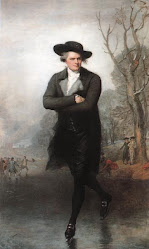Being interested in the time period of Samuel Meeker, I bought a book which was ‘discarded’ from the “Abraham Lincoln Junior High School Library” in Lancaster Pennsylvania. I must have found it online. The book is entitled “Social Life in the Early Republic” (Anne Hollingsworth Wharton, first published 1902) and I suppose I understand why it was eventually discarded, not offering exactly an intensive in-depth analysis of those times, but offering simple anecdotes of various noted families, their connections, and descriptions of dignified and charming individuals. Who married whom, who was renown and why, and inbetween interesting and worthy stories for example on the choice of the site of the new capital after it moved from Philadelphia, the architect and who owned the land etc. Lots of names. So, in the course of reading this book, on the topic of ‘homes and hostelries’, my interest was piqued with the following paragraph (and one can glean an idea of the writing style of the author):
“Blodget’s Hotel occupied the site of a portion of the Post-office Department. A house on Sixteenth Street, near what is now Scott Circle, was marked as that of Samuel Blodget in the early plans of Washington; but there is no record of the Blodget family having lived in the new city. Mrs. Blodget, daughter of the Rev. William Smith, first provost of the University of Pennsylvania, was a noted beauty, which reputation her portrait of Gilbert Stuart fully establishes. An independent, original woman Mrs. Blodget seems to have been, not hesitating to express her opinions freely about people and places, and very much amusing a recent acquaintance by announcing that her children “all resembled Mr. Blodget, having small eyes and a comical look.” One of her daughters she classified as “a beauty, but a vixen,” while another, she said, was “not pretty, but a sweet creature.”I determined to find an image of this exotic bird!
from Lawrence Park
Mrs. Samuel Blodget 1772-1837
Rebecca, daughter of the Reverend William and Rebecca (Moore) Smith of Philadelphia. It is said that she was one of the most admired beauties that ever adorned the drawing room of Philadelphia and as much distinguished by sprightliness and wit as by personal comeliness. In 1792 she married Samuel Blodget, Jr (1755-1814) of Woburn, Ma, Washington, District of Columbia, and afterwards Philadelphia, Pa.
~
Stuart also painted Rebecca's father the Reverend William Smith, whom he knew well. The stately gentleman has a big nose, similar to his daughter's. Perhaps I will show him next! Stuart "lived in a house owned by Smith's son William Moore Smith in Philadelphia, where at least one sitting with George Washington took place..." (Gilbert Stuart by Barratt and Miles p 227) Rebecca's portrait is unfinished, one has to wonder why in this case.
Husband Samuel Blodget Jr was an architect and assisted Stuart in the design of the backgrounds of his Landsdowne portrait of Washington and that of his father-in-law.
~
Mrs. Samuel Blodget
Philadelphia c.1798 by Gilbert Stuart
collection Pennsylvania Academy of Fine Arts











